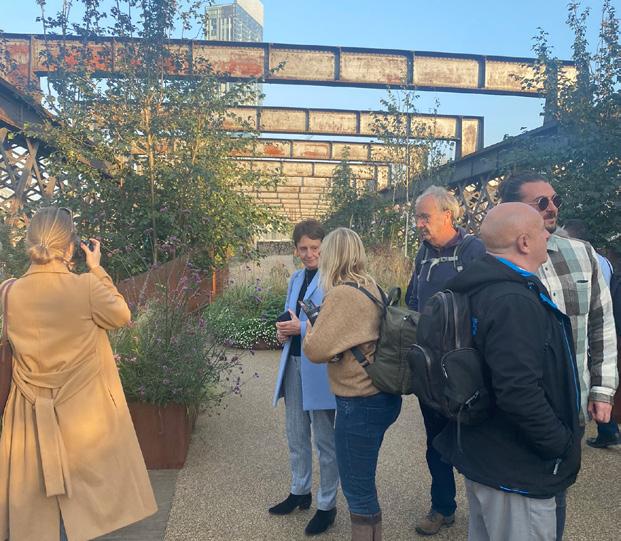
6 minute read
Counting Embodied Carbon – new report from the Landscape Institute and BALI to be published in the spring
With the urgent need for action on climate change by our sector, the focus of work this year for the Landscape Institute Policy Team will be the challenges and opportunities of carbon reduction. An Advisory Group is working to provide up to date advice for members, including a briefing report due for publication in the spring.
In June 2019, the Landscape Institute declared a climate and a biodiversity emergency. One of the first steps following the declaration was the publication of a Climate and Biodiversity Action Plan, committing the LI to take the following steps:
– Equipping the profession to provide solutions to the two emergencies
– Regulating and monitoring the sector to encourage greater sustainability
– Advocating for measures to address the emergencies with governments and industry
– Leading through our own sustainable business operations.¹
An important aspect of this work was an acknowledgement of the sector’s role in reducing the levels of both embodied and operational carbon in landscape schemes.
Embodied carbon refers to the entire greenhouse gas emissions generated in order to create a project. This includes carbon in the materials specified in the design and delivery of landscape schemes. It has significant implications for manufacturers and suppliers as there are carbon emissions at almost every stage of their processes, from the materials they use to grow plants or manufacture materials to the transport methods taking items to site. To fully understand the impact of this work, including the carbon emitted and the carbon potentially stored, it is important to address Whole Life Carbon Assessments. These consider the mitigation of carbon impact through the entire project lifecycle, from inception to demolition.
Choices made at the design and delivery stage of a scheme need to be calculated. For example, if a product has a low embodied carbon score but lasts for only three years, it may well be less effective than another product which may have a much higher carbon count but has been proven to enjoy a 30-year lifespan. At present, there is no single agreed process to follow to make this evaluation. Although guidance has been provided by organisations including RIBA, RICS and the Greater London Authority, this is not currently the case across the landscape sector.
Most tools currently in use focus on buildings and infrastructure rather than landscape, and mainly rely on data provided by the manufacturers of building components. Landscape design and construction doesn’t always match this formula – trees and plants aren’t exclusive to one supplier, but the research to assess the carbon emissions and any subsequent carbon sequestration is complex and a huge undertaking for small suppliers. At present, there is no single source or universal standard for data.
There are several emerging tools for the landscape sector and whilst the Institute cannot endorse any of these, we are keen to hear from practices and suppliers on their experiences of using them. One such tool is Pathfinder. Designed by San Francisco based landscape architect Pamela Conrad the free, web-based tool Pathfinder from Climate Positive Design allows practitioners to assess the carbon footprint of their project and the time expected for the scheme to become carbon neutral. Users enter the quantities and materials and the results are presented in an easy-to-understand format. Based on the design, the app provides recommendations for improving levels of carbon storage, such as creating wetland areas. As with other applications, there is a lack of UK suppliers or data for generic components, but the number of items is gradually increasing.
This one-way workflow, whilst providing valuable data, will add more time to the design process, in turn adding costs. If the data is required by the client or by legislation, then this will be a cost to all those bidding for the work and not create a financial disadvantage. However, when the decision to assess embodied carbon is made at practice level, the benefit of assessing the data needs to be understood by the client as part of the tender process.
The ideal for assessing embodied carbon within landscape design would be for the data to be generated as plans are created, calculating the embodied and sequestered carbon directly from the various elements, allowing early concepts to be tested and refinements made as the design evolves. This is already achievable for costings, using BIM, and some drafting packages are beginning to include carbon calculator tools, but again this relies on one standard used throughout the sector and work by suppliers to provide product data in this format.
To date, most of the tools are free to use, so there is no barrier for smaller practices which are disproportionally impacted by software costs. This should be a consideration with any future recommendations by the LI.
Landscape architects are wellplaced to play a central part in the work to reduce carbon emissions, mitigate climate impacts and to find opportunities to store carbon. Some landscape practices, manufacturers and suppliers have already embraced embodied and operational carbon considerations within their work and processes. Clients, particularly those who have embedded sustainability elsewhere within their businesses, will increasingly be turning their attention to carbon counting on scheme and onsite, with publicly-funded procurers likely to be amongst the first to stipulate whole-life carbon considerations as a condition of contract.
Quantifying and reducing the amount of embodied carbon within schemes will be both a challenge and opportunity for the entire landscape sector and could conceivably transform our working practice.
The Landscape Institute’s report briefing on embodied and operational carbon, produced in conjunction with the British Association of Landscape Industries (BALI), will be published in March 2023. The advisory group has plans for further deliverables later in the year and is keen to hear from practices, manufacturers, clients and contractors. What impact will reduce carbon counts have on the schemes you design, the products you manufacture, and the schemes you commission? If you have already started to incorporate embodied or operational carbon considerations and calculations within your work, or have ideas or experiences you’d like to share, we’d love to hear about your experiences at policy@landscapeinstitute.org

Alan Howard
Policy Manager at the Landscape Institute
References:
1 ‘Climate and biodiversity action plan', Landscape Institute, May 2020, <https:// landscapewpstorage 01.blob.core. windows.net/wwwlandscapeinstituteorg/2020/05/12284climate-biodiversityaction-plan.pdf>.










